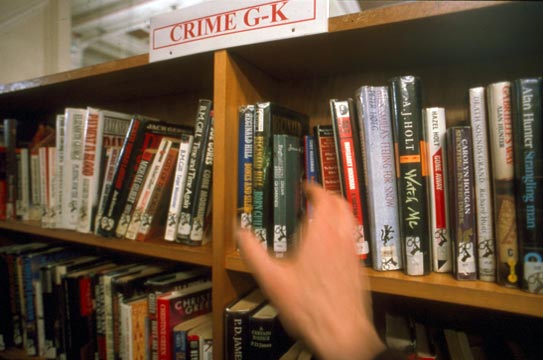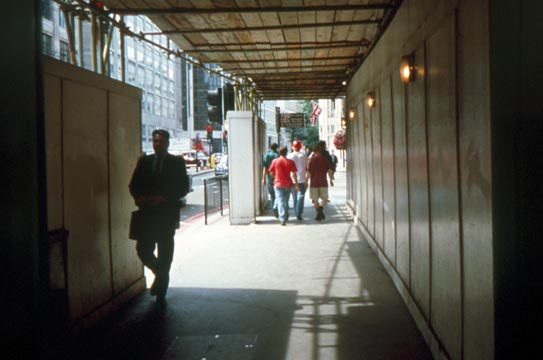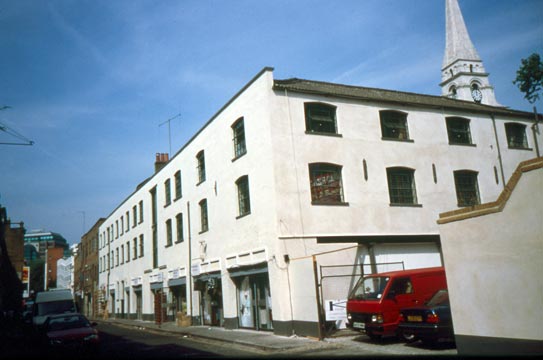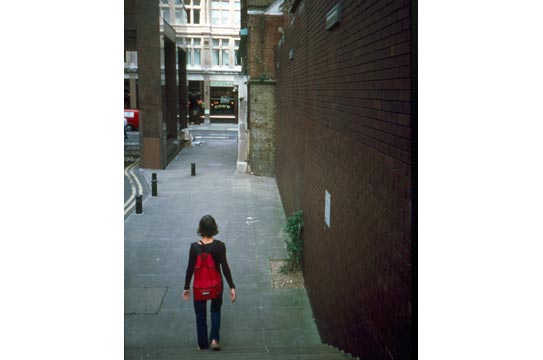





















Medium:
Audio walk
Duration:
50 minutes
Commissioner:
Commissioned and produced by Artangel. Whitechapel Library to Liverpool Street Station.
Janet Cardiff
| Sometimes I don’t really know what the stories in my walks are about. Mostly they are a response to the location, almost as if the site were a Rorschach test that I am interpreting. For me, The Missing Voice was partly a response to living in a large city like London for a while, reading about its history in quiet libraries, seeing newspaper headlines as I walked by the new stands, overhearing gossip, and being a solitary person lost amongst the masses. Normally, I live in a small town in Canada, so the London experience enhanced the paranoia that I think is common to a lot of people, especially women, as they adjust to a strange city. I was trying to relate to the listener the stream-of-consciousness scenarios that I constantly invent in my mind when I see someone pass or walk down a dark alley. It is one of my frustrations as well as entertainments to constantly have these visions and voices, which are quite often scary or violent, running through my brain as I encounter the simplest of realities. I think it is a desire to dramatize my life, make it real by making it cinematic – probably the result of reading too many detective novels or watching too many movies. Part of the process for the piece was to walk around and take notes on my mini voice recorder. While listening to these notes again in my apartment I realized how this voice became another woman, a character different from myself, a com-panion of sorts. This voice also seemed to metaphorically represent how we all have multiple personalities and voices. I saw the woman in the story not only as alienated from her self, but also searching for herself through this voice, play-acting, creating false dangers and love affairs, wanting her story dramatized. At the same time, her voiceover, the one that speaks in the third person, removes her from the story, and keeps her at a safe distance.
sound of phone ringing, receptionist answering Janet I’m standing in the library with you, you can hear the turning of newspaper pages, people talking softly. There’s a man standing beside me, he’s looking in the crime section now. He reaches to pick up a book, opens it, leafs through a few pages and puts it back on the shelf. He’s wandering off to the right. Pick up the book he looked at … it’s on the third shelf down. It’s called Dreams of Darkness, by Reginald Hill. I’m opening it to page 88. ‘She set off back at a brisk pace in a rutted and muddy lane, about a furlong from the house she thought she heard a sound ahead of her. She paused. She could hear nothing but her straining eyes caught a movement in the gloom. Someone was approaching. A foot splashed in a puddle. scary movie music rises during excerpt from book, girl screams, music fades out Janet Sometimes when you read things it seems like you’re remembering them. Close the book. Put it back to where you found it. Go to the right. Walk past the main desk. Through the turnstile. sound of voices, conversations Detective Man’s Voice, British accent One of the librarians recognized her from the photograph. Janet Turn to the right, Gunthorpe Street. A man just went into the side door of the pub. sound of tape recorder being stopped, rewound, replayed Janet recorded voice A man just went into the side door of the pub. sfx of recorder being stopped Detective Found in her bag, two cassette tapes with a receipt and a tape recorder … As far as I can tell she’s mapping different paths through the city. I can’t seem to find a reason for the things she notices and records. J vox recorded A naked man is walking up the street towards me. He’s walking as if he is sleeping, staring straight ahead. He walks past me without seeing me. sound of recorded being stopped Janet I dreamt last night that I was a soldier in a war who was sleeping, dreaming a nightmare through his dream, I dreamt of a giant, white polar bear covered in blood, chasing him down a gravel road. He dreamt of a tea bag already spent, soaking in clear water. He dreamt of flying over a vast forest. street sounds resume Detective Inside the package a wig, beige scarf, a linen suit, and leather shoes. Janet Go down the stairs. I keep thinking the package that I sent to him, it was a sign to tell him that she didn’t exist, that it was over, but I have a sick feeling that somehow it has something to do with her death. Keep going in the same direction. Detective I’ve started listening to her tapes at night in a darkened room. In the morning I set her picture across from me, while I eat my breakfast. Janet She’s getting on the train. He runs along the platform. Just as it’s pulling out of the station, she sees his face in the window and tries to hide. As the train picks up speed, she turns her head to watch him fade into the distance. I have to leave now. I wanted to walk you back to the library but there’s not enough time. Please return the Discman as soon as possible. Goodbye. sound of Janet walking away |
|
| In the city, you are in the company of strangers. Writing at the beginning of the twentieth century in Berlin, Georg Simmel identified this phenomenon as a central experience of the modern metropolis. “The stranger is near and far at the same time,” Simmel noted, “one who is close-by is remote [but] one who is remote is near.” London was not a city Janet Cardiff knew well when she arrived in January 1998 to think about a possible work. The Missing Voice is Cardiff ’s first work for a large modern metropolis. It is a work for a city where everyone is a stranger – a city where people come to lose themselves, or find themselves; a place where people go missing every day.
The way Artangel develops projects is very open, so there was a bewildering range of possibilities for Cardiff to consider. Perhaps the most crucial issues were how and where the work would begin and end. Starting in the Crime section of the Whitechapel Library, The Missing Voice winds its way through the streets of Spitalfields and into the bustling spaces of the City of London. It ends, quite abruptly, leaving the listener alone amongst the crowd, in the public concourse of Liverpool Street Station. Large numbers of people rush by or wait. The listener is asked to head back to the library, this time without the companionship of the voice guiding his or her steps. The question of how to end her narratives is always a complex one for Cardiff, and the ending of The Missing Voice marks a particularly brave and open resolution. One aspect of the work which we frequently discussed was its duration. We were both interested to see what might be possible if the length of the experience could be extended. It was not, as the walks at the Louisiana Museum or in Münster or São Paolo had been, part of a large exhibition or connected to a museum. It would be out there, in the city, on its own. When the editing was complete, The Missing Voice was significantly longer than any walk Cardiff had previously completed. This allowed for different layers of narrative to unfold and for the city itself to become a central character. The female narrator is featured in two guises – as a voice guiding you through the present, and as a recording that recounts personal and civic traumas. The tape of the recording is now in the hands of somebody else, a detective trying to reconstruct the missing person’s movements and her motives. A male voice occasionally emerges – perhaps the lover of the narrator? Who has gone missing, and why? Is she really missing or has she deliberately disappeared? Did we see her rushing by? The various voices entangle with the city through which Cardiff ’s walk takes us – a city which, as the narrator tells us, “is infinite. No-one has ever found an end to the pattern of streets.” Near the end of the editing phase, which took several weeks, I had some concern that some of the particular details the narrator was describing would not be there for very long. When the work was ready, I realized this was not an issue. Conceived for, made for, and experienced within a particular part of a particular city, Janet Cardiff ’s walks paradoxically thrive on the disjuncture between what is being heard or described and what is being seen. After five years and some 20,000 other participants, I just borrowed The Missing Voice from Whitechapel Library again. The disjunctures have become gradually more pronounced, but the work holds together just as well. I won-der now what the experience of the work will be like in a hundred years’ time. There will be no library, no lime green Ford Capri, maybe there will be no railway station. Perhaps the station will, as the recorded voice describes, be “empty … blackness and rubble everywhere … holes in the glass roof.” But I imagine the city will still be there, full of strangers. And the desire to disappear will be there too. James Lingwood |